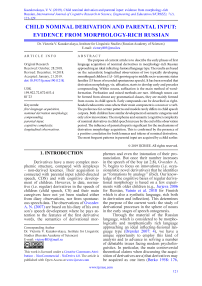Child nominal derivation and parental input: evidence from morphology-rich Russian
Автор: Victoria V. Kazakovskaya
Журнал: International Journal of Cognitive Research in Science, Engineering and Education @ijcrsee
Рубрика: Original research
Статья в выпуске: 1 vol.7, 2019 года.
Бесплатный доступ
The purpose of current article is to describe the early phases of first language acquisition of nominal derivatives in morphology-rich Russian approaching an ideal inflecting-fusional language type. The results are based on the naturalistic longitudinal observations of two typically developing monolingual children (1;5-3;0) growing up in middle socio-economic status families (33 hours of recorded spontaneous speech). It has been revealed that derivation morphology, viz. affixation, starts to develop early and precedes compounding. Within nouns, suffixation is the main method of word-formation. Prefixation and mixed methods are rare. Although nouns can be formed from almost any grammatical classes, they are mainly formed from nouns in child speech. Early compounds can be described as right-headed endocentric ones where their main component is a noun or a verb. The preference for certain patterns and models rarely differs in child speech corpora. Both children have similar development of semantic categories and only a few innovations. The morpheme and semantic (cognitive) complexity of nominal derivatives in child speech increase by the end of the observation period. The influence of parental input is significant for the mechanisms of derivation morphology acquisition. This is confirmed by the presence of a positive correlation for both lemmas and tokens of nominal derivatives. The most frequent patterns in parental input are acquired by a child earlier.
First language acquisition, nominal derivation morphology, compounding, parental input, cognitive complexity, longitudinal observations
Короткий адрес: https://sciup.org/170198538
IDR: 170198538 | УДК: 159.922.72.072-053.4 | DOI: 10.5937/ijcrsee1901121K


